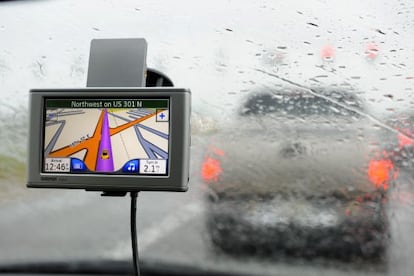Kings of the road apps
There are dozens of cellphone programs aimed at making drivers' lives easier They can warn about speed cameras or even tell you where you parked your car


Spain's highway agency (DGT) has just added its contribution to the trend for innovative technology aimed at drivers. The organization responsible for the Spanish road network has created its own application — available for both iPhone and Android — to help motorists plan their routes and keep them informed about traffic incidents, speed cameras and weather conditions.
But there are many more cellphone applications that provide drivers with information about their vehicles or the roads. EL PAÍS takes you for a spin around some of the best...
Traffic information. As well as the DGT cellphone app, a program from the Royal Automobile Club of Spain (RACE), as well as RACC Infotransit, Michelin Tráfico and Waze, all provide drivers with traffic information.
Finding your car. Cellphone technology has solved the problem of remembering where you parked. Numerous applications exist that will locate your vehicle for you, including Find My Car-GPS Navigation and eLibera's Find My Car.
Saving on fuel. Gasolineras Baratas (Cheap gas stations) and RACC Infotransit locate the nearest service station, as well as providing information on fuel prices, which are updated on a daily basis. You can also save on fuel using EcoShifter (Android only), which keeps you informed about which gear you should be in to drive as efficiently as possible, based on your speed and engine revolutions. To use it, though, your car will need to have two vehicle diagnostics technology systems installed: an ELM327 microcontroller and an OBD2 system.
Your car in your phone. The application Volvo on Call, only available for vehicles made by the Swedish manufacturer, allows you to control your car from your iPhone or Android smartphone. It includes features for locating your car using Google Maps, setting your horn honking and flashing your lights for five seconds. It also lets you use your phone to check if you have forgotten to close your doors or windows, as well as to lock or unlock your vehicle. What's more, you can also turn on the air-conditioning remotely so you can get the interior of your car to the right temperature for when it is time to drive.
Hands free. With the aim of preventing the distractions of cellphones, applications such as Text'nDrive read out your text messages for you and even allow you to reply by voice. Meanwhile, other programs, including TextSTAR and Safe Driver, hold your calls and messages until they detect that your car has stopped. You can even program the apps to send a message to the caller to let them know you are driving.
Vehicle diagnostics. The Torque cellphone application gives your car a check over, providing information on the engine — temperature, revolutions per minute, fuel consumption — and detecting both mechanical and electrical faults, such as, for example, if a headlight or fuse has blown.
It also lets you know your car's water and oil temperature and many repair shops are already using it to check the condition of vehicles.
The application is free to download in some versions, but to use it you will also need an adaptor to connect the cellphone to the car. Once plugged in, the information reaches your cellphone wirelessly via Bluetooth technology.
Speed cameras. GPS devices and almost every cellphone application that keeps you up to date about traffic information lets you know the location of speed cameras and even areas where mobile radar traps are situated.
One of the newest is Wikango, which has created a community of users who are connected while they are driving — 1.5 million, according to its figures — allowing motorists to warn others on the road about speed traps, thus getting round the ban on radar scanners that was proposed in the new highway regulations.
When you press the screen, the system memorizes the position of the trap and sends the information to all other road users in the area. The application's maker warns users that they should "check current legislation in the country where you want to use it." In Spain it is forbidden to drive while manually using cellphones, navigation systems or other communications devices.
Tu suscripción se está usando en otro dispositivo
¿Quieres añadir otro usuario a tu suscripción?
Si continúas leyendo en este dispositivo, no se podrá leer en el otro.
FlechaTu suscripción se está usando en otro dispositivo y solo puedes acceder a EL PAÍS desde un dispositivo a la vez.
Si quieres compartir tu cuenta, cambia tu suscripción a la modalidad Premium, así podrás añadir otro usuario. Cada uno accederá con su propia cuenta de email, lo que os permitirá personalizar vuestra experiencia en EL PAÍS.
¿Tienes una suscripción de empresa? Accede aquí para contratar más cuentas.
En el caso de no saber quién está usando tu cuenta, te recomendamos cambiar tu contraseña aquí.
Si decides continuar compartiendo tu cuenta, este mensaje se mostrará en tu dispositivo y en el de la otra persona que está usando tu cuenta de forma indefinida, afectando a tu experiencia de lectura. Puedes consultar aquí los términos y condiciones de la suscripción digital.
Últimas noticias
The complicated life of Francesca Albanese: A rising figure in Italy but barred from every bank by Trump’s sanctions
Half of Scotland is in the hands of 420 property owners
Reinhard Genzel, Nobel laureate in physics: ‘One-minute videos will never give you the truth’
Pinochet’s victims grapple with José Antonio Kast’s rise in Chile
Most viewed
- Pablo Escobar’s hippos: A serious environmental problem, 40 years on
- Why we lost the habit of sleeping in two segments and how that changed our sense of time
- Charles Dubouloz, mountaineering star, retires at 36 with a farewell tour inspired by Walter Bonatti
- Trump’s obsession with putting his name on everything is unprecedented in the United States
- The Florida Keys tourist paradise is besieged by immigration agents: ‘We’ve never seen anything like this’








































